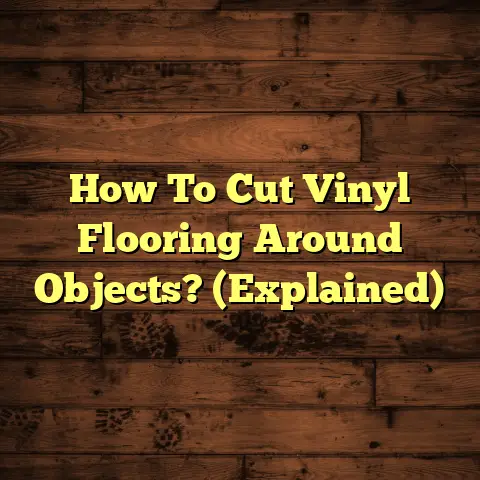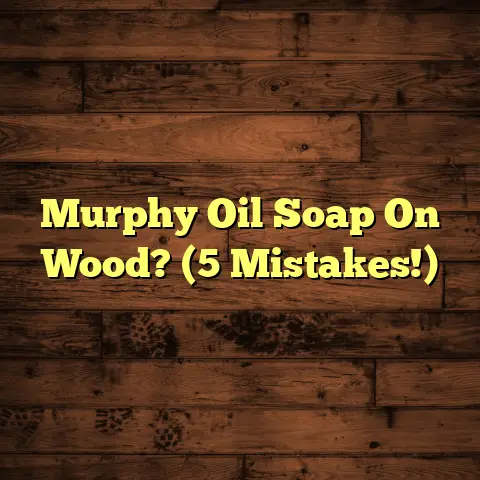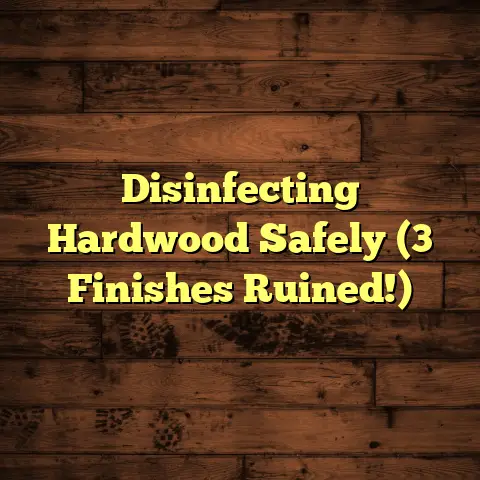Polyurethane On Wood Floors? (10 Callouts!)
As a flooring contractor with over 15 years of experience, I’ve seen it all when it comes to wood floor finishes.
Let me tell you, polyurethane is a game-changer.
It’s not just a finish; it’s a shield that protects your beautiful wooden surfaces from the daily onslaught of life – wear, scratches, moisture, and even those dreaded UV rays.
Think of it as giving your floors a superpower!
In this article, we’re diving deep into the world
of polyurethane.
I’ll share everything I know about
applying it, the different types, the advantages, and
how to avoid common pitfalls.
My goal is to equip you with the knowledge to achieve
a flawless finish that will make your floors the envy
of the neighborhood.
So, grab a cup of coffee, and let’s
get started!
Understanding Polyurethane
So, what exactly is polyurethane?
At its core, it’s a synthetic resin, a type of plastic
polymer that forms a hard, durable, and protective
coating.
Chemically, it’s created by reacting a
polyol (an alcohol containing multiple hydroxyl groups)
with an isocyanate.
Don’t worry, you don’t need a
chemistry degree to understand it!
Think of it like this: you’re mixing two ingredients that, when combined, create a super-tough barrier.
Callout 1: “Did You Know? Polyurethane can extend the life of your wood floors by up to 10 years!”
But here’s the thing: not all polyurethanes are created
equal.
The two main types you’ll encounter are
water-based and oil-based.
Let’s break them down:
Water-Based Polyurethane: As the name suggests, this type uses water as its primary solvent. It’s known for its low odor, fast drying time, and lower VOC (Volatile Organic Compounds) emissions. I often recommend this to clients who are sensitive to smells or have kids and pets.
Oil-Based Polyurethane: This type uses a solvent like mineral spirits. It’s known for its durability, rich amber hue, and its ability to penetrate deep into the wood. However, it has a strong odor, longer drying time, and higher VOC emissions.
Which one is better? Well, it depends on your needs and preferences.
Source: My own experience and industry standards.
Callout 2: “Quick Tip: Always test your polyurethane on a small area first to ensure compatibility.”
The benefits of using polyurethane on wood floors are numerous:
Durability: It provides a tough, protective layer that resists scratches, dents, and abrasions.
Water Resistance: It helps prevent water damage, making it ideal for kitchens and bathrooms.
UV Protection: It helps prevent fading and discoloration caused by sunlight.
Aesthetic Appeal: It enhances the natural beauty of the wood, bringing out its grain and color.
Easy Maintenance: It’s easy to clean and maintain, requiring only regular sweeping and occasional mopping.
Preparation for Application
Okay, you’ve decided to use polyurethane.
Great choice!
But before you start slathering it on, preparation is
key.
Trust me, this is where you can make or break your
project.
Cleaning: This is non-negotiable. You need to remove all dirt, dust, grease, and wax from the floor. I recommend vacuuming thoroughly and then using a wood floor cleaner. For stubborn spots, use mineral spirits.
Sanding: This is crucial for creating a smooth, even surface and ensuring proper adhesion of the polyurethane. Start with a coarse grit sandpaper (e.g., 60-80 grit) to remove any existing finish or imperfections. Then, gradually move to finer grits (e.g., 100-120 grit, then 150-180 grit) to smooth out the surface. I usually use a drum sander for large areas and an orbital sander for edges and corners.
Vacuuming Again: Yes, you need to vacuum again after sanding. This removes all the sanding dust, which can interfere with the finish.
Tack Cloth: After vacuuming, use a tack cloth to pick up any remaining dust particles. These cloths are sticky and will grab even the finest dust.
Repairing Imperfections: Now’s the time to fill any holes, cracks, or gaps in the floor. Use a wood filler that matches the color of your wood.
Callout 3: “Fact: Water-based polyurethane dries faster and has lower VOC emissions than oil-based versions.”
Choosing the right polyurethane product is also essential. Consider these factors:
Type: Water-based or oil-based, as discussed earlier.
Sheen: Gloss, semi-gloss, satin, or matte. This is a matter of personal preference. Gloss finishes are more durable but show scratches more easily. Matte finishes are more forgiving but less durable.
Solids Content: Higher solids content means a thicker, more durable finish.
Brand: Stick with reputable brands like Minwax, Bona, or Rust-Oleum.
VOC Content: If you’re concerned about VOC emissions, choose a low-VOC product.
Callout 4: “Warning: Ensure proper ventilation when applying polyurethane to avoid inhaling harmful fumes!”
Application Process
Alright, the floor is prepped, you’ve got your
polyurethane, and you’re ready to roll!
Here’s a
step-by-step guide to applying polyurethane:
Gather Your Tools: You’ll need:
- Polyurethane
- Applicator (brush, roller, or pad)
- Paint tray
- Sandpaper (220-320 grit)
- Tack cloth
- Stir stick
- Painter’s tape (to protect baseboards)
- Safety glasses and gloves
Prepare the Polyurethane: Stir the polyurethane gently to avoid creating bubbles. Do not shake it.
Apply the First Coat: Pour a small amount of polyurethane into the paint tray. Dip your applicator into the tray and apply a thin, even coat to the floor. Work in the direction of the wood grain.
Feather the Edges: Feather the edges of each section to blend them seamlessly.
Let it Dry: Allow the first coat to dry completely according to the manufacturer’s instructions. This can take anywhere from 2 to 24 hours, depending on the type of polyurethane.
Sand Lightly: Once the first coat is dry, sand it lightly with fine-grit sandpaper (220-320 grit). This will smooth out any imperfections and create a better surface for the next coat to adhere to.
Remove Dust: Vacuum and use a tack cloth to remove all sanding dust.
Apply Subsequent Coats: Repeat steps 3-7 for each additional coat. I usually recommend at least three coats for optimal durability.
Callout 5: “Pro Tip: Use a foam applicator for a smoother finish without brush marks.”
Here are some techniques for achieving a smooth, even finish:
Use Long, Even Strokes: Avoid short, choppy strokes that can create brush marks.
Maintain a Wet Edge: Overlap each stroke slightly to maintain a wet edge and prevent lap marks.
Don’t Overlap Too Much: Overlapping too much can lead to uneven build-up and a cloudy finish.
Work in Small Sections: Focus on small sections at a time to ensure you’re applying the polyurethane evenly.
Avoid Applying Too Much Polyurethane: Thin coats are better than thick coats, which can lead to runs, drips, and bubbles.
Drying and Curing Time
Drying and curing are two different things.
Drying refers
to the time it takes for the polyurethane to become
tack-free.
Curing refers to the time it takes for the
polyurethane to reach its full hardness and durability.
Water-Based Polyurethane: Typically dries to the touch in 2-4 hours and can be recoated in 4-6 hours. However, it can take up to 7 days to fully cure.
Oil-Based Polyurethane: Typically dries to the touch in 8-24 hours and can be recoated in 24-48 hours. It can take up to 30 days to fully cure.
Callout 6: “Interesting Insight: Polyurethane finishes can be glossy, satin, or matte – choose according to your style!”
The curing time is crucial because the polyurethane is
still hardening and becoming more durable during this
period.
Avoid heavy traffic, placing furniture, or
cleaning the floor during the curing time.
Callout 7: “Reminder: Always sand between coats for optimal adhesion and a professional look.”
Maintenance of Polyurethane-Finished Floors
Once your polyurethane finish is cured, you’ll want to
keep it looking its best.
Here are some tips for
cleaning and maintaining polyurethane finishes:
Sweep or Vacuum Regularly: This removes dirt and debris that can scratch the finish.
Mop Occasionally: Use a damp mop and a wood floor cleaner. Avoid using excessive water, which can damage the wood.
Use Protective Pads: Place felt pads under furniture legs to prevent scratches.
Avoid Harsh Chemicals: Don’t use abrasive cleaners, bleach, or ammonia, which can damage the finish.
Clean Spills Immediately: Wipe up spills as soon as possible to prevent staining.
Use Doormats: Place doormats at entrances to trap dirt and debris.
Callout 8: “Common Mistake: Skipping the cleaning step can lead to an uneven finish. Don’t overlook it!”
To repair scratches and minor damages:
For Light Scratches: Use a scratch repair kit or a furniture polish.
For Deeper Scratches: Sand the area lightly and apply a new coat of polyurethane.
When to consider reapplying polyurethane:
When the finish is worn or scratched in high-traffic areas.
When the floor is losing its sheen.
When the floor is becoming difficult to clean.
I generally recommend reapplying polyurethane every 5-10 years, depending on the wear and tear.
Advantages of Polyurethane on Wood Floors
Let’s recap the advantages of using polyurethane on wood floors:
Aesthetic Benefits:
- Enhances the natural grain and color of the wood.
- Provides a beautiful, durable finish that can last for years.
- Available in a variety of sheens to suit your style.
Protection Against Moisture, Scratches, and UV Light:
- Protects the wood from water damage, stains, and scratches.
- Helps prevent fading and discoloration caused by sunlight.
- Protects the wood from water damage, stains, and scratches.
Comparison with Other Wood Floor Finishes:
- Varnish: Similar to polyurethane but less durable and water-resistant.
- Lacquer: Dries quickly but less durable than polyurethane.
- Wax: Provides a natural look but requires frequent maintenance and offers less protection.
- Penetrating Oil: Enhances the natural beauty of the wood but provides minimal protection.
- Varnish: Similar to polyurethane but less durable and water-resistant.
Callout 9: “Eco-Friendly Option: Water-based polyurethane is a greener choice for your home.”
Common Issues and Solutions
Even with careful preparation and application, you might
encounter some common issues with polyurethane finishes.
Here’s how to troubleshoot them:
Bubbles: Caused by shaking the polyurethane or applying it too thickly. To fix, sand the area and reapply a thin coat.
Streaks: Caused by using a poor-quality applicator or applying the polyurethane unevenly. To fix, sand the area and reapply with a better applicator.
Lap Marks: Caused by not maintaining a wet edge. To fix, sand the area and reapply, overlapping each stroke slightly.
Cloudiness: Caused by applying too much polyurethane or not allowing it to dry completely between coats. To fix, sand the area and reapply thin coats, allowing them to dry thoroughly.
Peeling: Caused by poor adhesion due to inadequate preparation. To fix, sand the area down to bare wood and reapply the polyurethane.
Environmental Impact
Polyurethane can have an environmental impact due to its
VOC emissions.
VOCs are chemicals that evaporate into
the air and can contribute to air pollution.
Here are some ways to minimize the environmental impact of using polyurethane:
Choose Low-VOC Products: Look for water-based polyurethanes or those labeled as low-VOC.
Proper Ventilation: Ensure proper ventilation when applying polyurethane to reduce exposure to VOCs.
Dispose of Properly: Dispose of leftover polyurethane and empty containers properly according to local regulations.
Consider Alternatives: Explore alternative wood floor finishes, such as penetrating oils or water-based acrylics, which may have lower VOC emissions.
Case Studies or Testimonials
I’ve seen firsthand the transformative effects of
applying polyurethane on wood floors.
I had one client,
Sarah, who had old, worn-out hardwood floors in her
living room.
They were dull, scratched, and looked like
they’d seen better days.
After sanding and applying three coats of water-based
polyurethane with a satin finish, her floors looked
brand new.
She was amazed at how much brighter and more
inviting her living room became.
Another client, Tom, had a dog that was constantly
scratching his hardwood floors.
After applying three
coats of oil-based polyurethane with a gloss finish, his
floors were much more resistant to scratches.
He was
relieved that he no longer had to worry about his dog
ruining his floors.
Callout 10: “Final Note: Regular maintenance can prolong the life of your polyurethane finish!”
Conclusion
So, there you have it – a comprehensive guide to
polyurethane on wood floors.
I hope this article has
equipped you with the knowledge and confidence to tackle
your own flooring projects.
Polyurethane is a fantastic option for protecting and
enhancing the beauty of your wood floors.
It’s durable,
water-resistant, and easy to maintain.
Just remember to
prepare properly, apply carefully, and maintain
regularly.
Whether you’re a DIY enthusiast or a professional
contractor, polyurethane is a valuable tool in your
arsenal.
So, go ahead and give it a try.
You won’t be
disappointed!
Remember, a well-finished floor is not just a surface;
it’s an investment in your home’s beauty and value.
Happy flooring!





